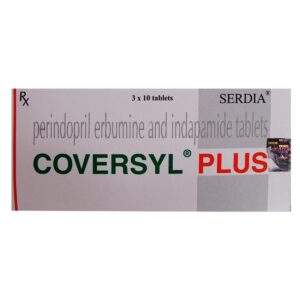INDAPAMIDE + PERINDOPRIL
Indapamide: Indapamide is a medication that is primarily used to treat high blood pressure (hypertension). It belongs to a class of drugs known as diuretics or water pills.
The primary mechanism of action of Indapamide is the inhibition of sodium reabsorption in the kidneys, leading to increased excretion of sodium and water from the body. By promoting the elimination of excess fluid, it helps to decrease blood volume and lower blood pressure.
The usual recommended starting dose of Indapamide for hypertension is 1.25 mg once daily. However, the dosage may vary depending on individual patient factors and response to treatment. It is important to follow the prescribed dosing instructions provided by the healthcare professional.
Like any medication, Indapamide can cause side effects. Common side effects may include dizziness, headache, nausea, stomach upset, and low potassium levels (hypokalemia). It is important to monitor potassium levels regularly while taking Indapamide, as low potassium can lead to certain symptoms such as muscle weakness, fatigue, and irregular heartbeat.
Other potential side effects that may occur less frequently but should be reported to a healthcare professional include rash, itching, increased urination, electrolyte imbalances, gout flares, and changes in blood sugar levels.
It is important to note that Indapamide may interact with other medications, so it is crucial to inform the healthcare professional about all the medications, supplements, and herbal products being taken.
Indapamide may not be suitable for everyone, so it is essential to consult with a healthcare professional to assess its appropriateness and to receive guidance on its use.
Perindopril: Perindopril is a medication that belongs to a class of drugs known as angiotensin-converting enzyme (ACE) inhibitors. It is primarily used to treat high blood pressure (hypertension) and heart failure.
The mechanism of action of perindopril involves inhibiting the activity of ACE, an enzyme that converts angiotensin I to angiotensin II. By inhibiting this enzyme, perindopril reduces the levels of angiotensin II in the body. This leads to vasodilation and a decrease in peripheral resistance, resulting in a reduction in blood pressure. Additionally, perindopril may help to protect the heart and improve cardiac function in patients with heart failure.
The typical starting dose of perindopril for hypertension is 4mg once daily, which can be increased to a maximum dose of 8mg per day if needed. For heart failure, the starting dose is usually 2mg once daily, which can be increased gradually to a maximum dose of 8mg per day.
Common side effects of perindopril include dizziness, headache, cough, fatigue, and gastrointestinal disturbances such as nausea, vomiting, and diarrhea. These side effects are usually mild and transient. Rare but serious side effects can include allergic reactions, kidney problems, liver dysfunction, and low blood pressure. It is important to monitor kidney function and blood pressure regularly while taking perindopril.
Perindopril is generally well-tolerated and effective in lowering blood pressure and managing heart failure. However, it is essential to take the medication as directed by a healthcare professional and to report any concerning side effects promptly.


